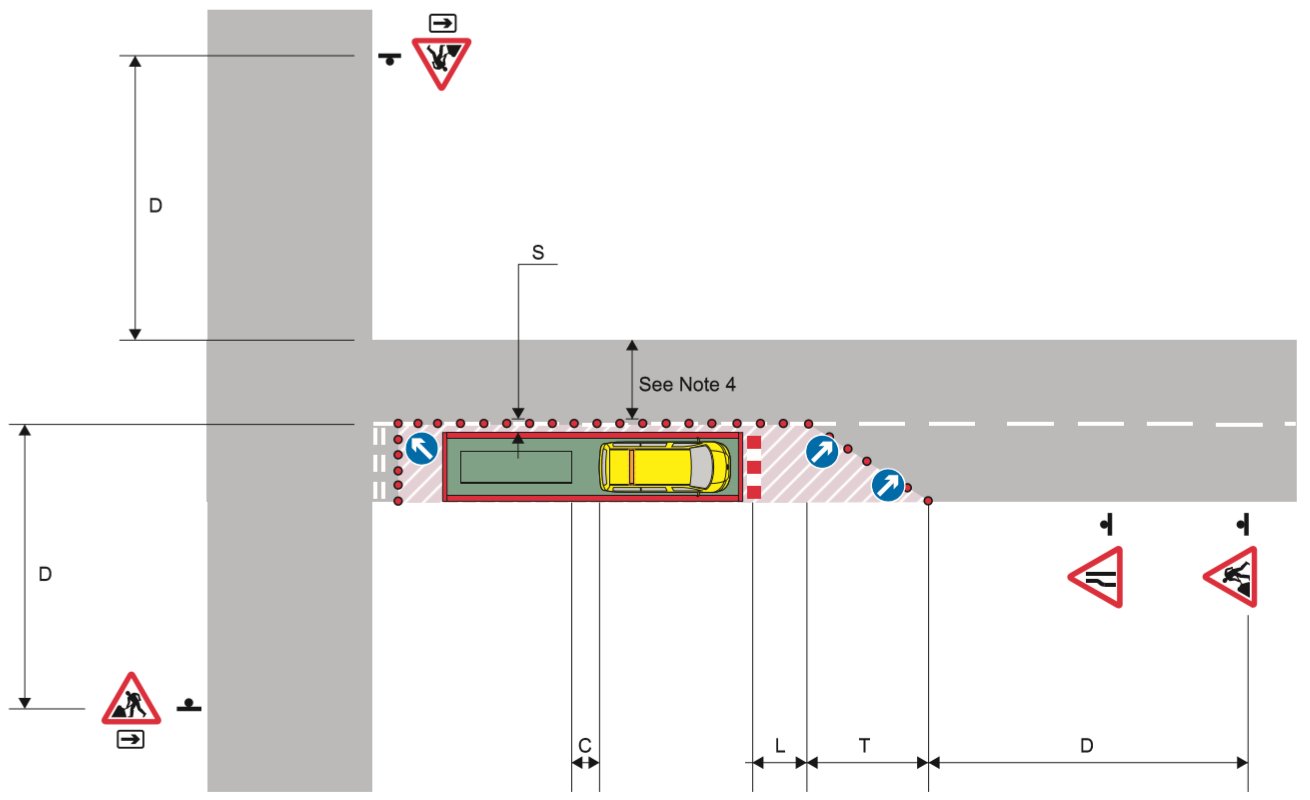Keep two-way traffic flowing past the works if possible. If you can’t, traffic control or a diversion will be required and you should refer to your supervisor, manager or other competent person. If the works are in a side road, place ‘Road works ahead’ signs with supplementary arrow plates on the main route. See figures Works in a side road a T-junction and Works on a signal island at a T-junction below for details. Where works are situated near but just past a side road junction, the cone taper can start on the approach to the junction.
Warning: When working adjacent to or on road junctions controlled by permanent traffic signals, you should consult your supervisor, manager or other competent person, and the highway authority must be contacted.
Approaches to signal controlled junctions
A works site on the approach to a signal controlled junction can cause significant traffic disruption at the junction itself. An adjustment of the traffic signals may be required, so consult your supervisor, manager or other competent person, who will then consult the highway authority.
At signal controlled junctions
If permanent traffic signals are not working, or have been turned off, you must ensure that ‘Light signals ahead not in use’ signs are erected on all approaches. Permanent traffic signals are often replaced by temporary or portable traffic signals for the duration of the works. If pedestrian lights at a junction are affected by the works, the crossing point should be closed off in a similar manner to that shown for pedestrian crossings (see the Works at pedestrian, cycle (Toucan) and equestrian crossings section of this Code).
Caution: Permanent traffic signals or pedestrian crossings can only be switched off or replaced by temporary or portable signals with the approval of the highway authority.
The diagram below (Works on a signal island at a T-junction) shows guarding and signing for works at traffic signals on a road with a speed limit of 30 mph or less.
 Notes
Notes
- For numbers and minimum size of cones, and dimensions D, T, C, L and S, see table in the Setting out site section of this Code.
- An information board (omitted here for clarity) must be displayed.
- Appropriate advance warning signs should be placed on all roads approaching the junction.
- See the Traffic control section of this Code for guidance on unobstructed width past the works.
- If two-way flow cannot be maintained past the works, some form of traffic control will be required – see the Traffic control section of this Code. Alternatively, flow could be made one-way, using advance No left turn/right turn signs placed in the main road to prevent vehicles from turning into the side road.
 Notes
Notes
- For numbers and minimum size of cones, and dimensions D, T, L and S, see table in the Setting out site section of this Code.
- An information board (omitted here for clarity) must be displayed.
- Appropriate advance warning signs should be placed on all roads approaching the junction.
- See the Traffic control section of this Code for guidance on unobstructed width past the works.
- If two-way flow cannot be maintained past the works in the side road, some form of traffic control will be required – see the Traffic control section of this Code. Alternatively, flow in the side road could be made one-way, using advance No left turn/right turn signs placed in the main road to prevent vehicles from turning into the side road.
 Notes
Notes
- For numbers and minimum size of cones, and dimensions D, T, L and S, see table in the Setting out site section of this Code.
- An information board (omitted here for clarity) must be displayed.
- Appropriate advance warning signs should be placed on all roads approaching the junction.
- See the Traffic control section of this Code for guidance on unobstructed width past the works.
- The length of the coned area may be extended to accommodate a works vehicle.
Appropriate advance warning signs should be placed on all roads approaching the junction. Consult your supervisor, manager or other competent person where the road has a speed limit of 40 mph or more.
